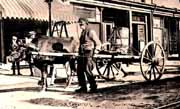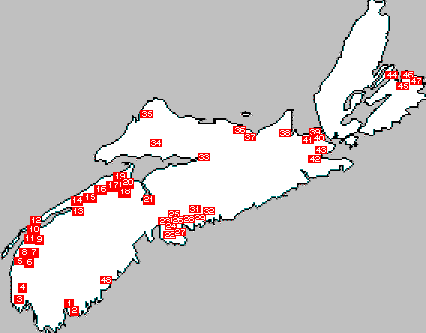| Families that still live in
Greenville are:
THE LAWRENCE'S Sherry, Oscar, Marge, Lorenzo( wife of Elly) Sherry L. Sr. wife is Yvonne, and son Sherry Jr.
MILLER'S Edward, Mert Miller
JOHNSON'S George and Belle Johnson's children were Calvin, Donna, Junior, Peter, Colin. Mary and Clarence Johnson, Lou, Arthur, Sherron, Derald, and Jenny children of parents were Jake and Cass Johnson. FALLS Glenn, and Vera ( parents of Dorothy and Clarence and have a daughter named Shavonne. Rudy, grandson, Gary, husband, Clarence, grand-daughter; Seron.
|
| Black History
In 1850,a few Blacks left Halifax and sailed to Sierra Leone, which is found in Africa. Due to this, the Black population diminished extremely. To follow in the footsteps of the Maroons, many more came to NS and disperset province wide. Since they arrived, the Revolutionary War started. Men young and old wanted to enlist in the Army so that they can do pride for their beloved country and queen only many were rejected due to the basic fact of their race. Some went to Sussex, NB to enlist there but the administration officer plainly said that they did not want to recruit them because that they did not want to have a "checker board army". These men were not about to give up, and that was when the No.1 Black Battalion was formed in Pictou, NS.
|
 |
| There are alot of people from Greenville that I've learned are related
to me and my cousin that is doing this project with me. Charles
Smith is the grandfather of the boys basketball coach, Chuck Smith.
George Fells is the great grandfather of Vanessa Fells. Albert Johnson
is my great cousin. These are members of the Brothers Club.
There also were a lot of famous black people in Nova Scotia believe it or not. Here are some of them. - Sam Langford seventh ranked heavy weight champion of all times. Internationally hailed the " the uncrowned champion " of the world. Born in Weymouth, N.S. March 4, 1883. He died in Boston Massachusetts Jan.12/1956. A gentlemen of proven skill and courage in the ring, he maintained the courage during his later years of adversity. Erected by the Weymouth Falls community council and friends in Nova Scotia June 1972. CROMWELL
|
|
 |
| How blacks got to Nova Scotia
1749 - Halifax
Black refugees
Black pioneers came to Nova Scotia in two major migrations, 1783
and 1813, from the Thirteen British Colonies which became the United
States of America. Most Black Pioneers came to Nova Scotia by ship.
1500 Black Pioneers landed at Port Roseway, now Shelburne. Black
Pioneers arriving in 1813 landed at the busy port of Halifax and
at Annapolis Royal.
|
| Black
Cultural Center
In Nova Scotia we also have a Black Cultural Center. In this
center black students or even white students can learn more about
the slavery and there culture. They can become more aware of what
happened in the 18th century and even in the forties, fifties and
sixties. The cultural center was opened in 1983. The center also
has plays, music, actives, and exhibitions.
|
| Community Events
- In Yarmouth we also do some special occasions for the Black community. At Christmas time we always get together at the Hubert Brush Centre and bring in a black Santa Claus for the children. He gives out treats and asks them what they want for Christmas. Then after that we usually have cake and juice for the kids to go along with there treat bags. |
 |
| -In the summer time there usually is a bible school that goes on
in the Hubert Brush center. When I use to go they use to bring
us to Liverpool. We use to go up for a week and stay in what
we would call the" Crudy Shack". My cousins and I use to call it
that because it looked like a big tin can and we weren't aloud to
shower no longer than 5 min. The Christian camp was fun but I was
only little so I wanted to go home. We did lots of crafts and
learned about our heritage and about Jesus Christ. We came back in a week and the camp leader told my mother that I had the devil in me . She laughed and said she would send me to church and back to camp next year. -Some other occasions we have are some dances out in Greenville for
the black community. The dances are supervised by adults and there
is a certain age limit that is required. The dances usually last
from eight to eleven.
|
 |
- The other thing we hold for our black community is an black awareness
dinner at the Youth Center. At the center Ada Fells hands out awards
for some of the black students that have improved in there school
work and that have passed the school year to go into another grade
or to college. At the dinner there are black students from grades
6 and up. Plus the children get
something so that they don't feel left out. The dinner last about two hours. |
| - And of course there is February, which is black history month.
We don't really celebrate that month. Well you can say we do, we
celebrate by learning more about our culture. Some other places
they might do more than
we do but we do let everybody know that is Black History Month. We sell T- shirt's and hats, mug and books on Black History. - That is about all the things I know about that goes on in our town
and communities. There is something in Halifax that goes on for
their community. There is a basketball tournament that goes on and
they call it
- There is also an special occasion in Weymouth Falls. There is an reunion that goes on every three years. This reunion is held for the Jarvis family, and the Fells and the Smiths. It is also held for alot more families but it would be impossible to name off all the families. Last year there was over 2000 people and we were all related. That gave us a chance to meet all of our relatives that we never met before. My father, Everett Jarvis had just met his four sisters at the Weymouth Reunion. It was a huge occasion and there was lots of good foods. They held it by my Grandmothers house that just recently just died this past February. There was over one hundred families there. |